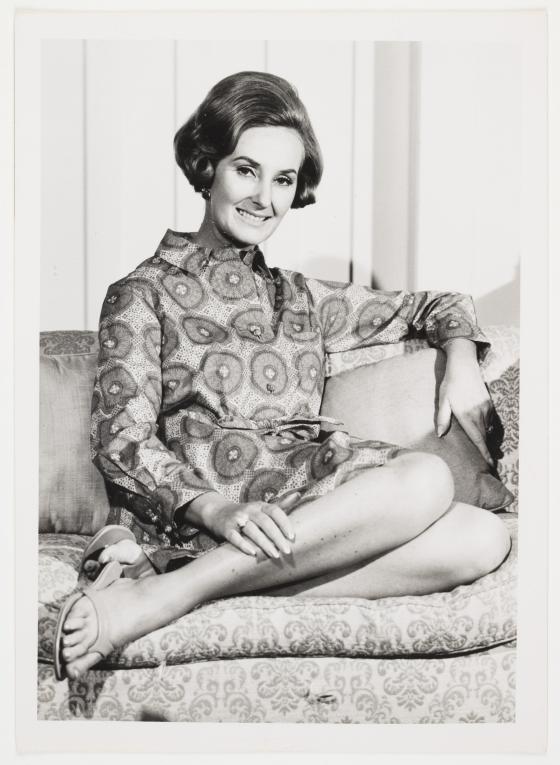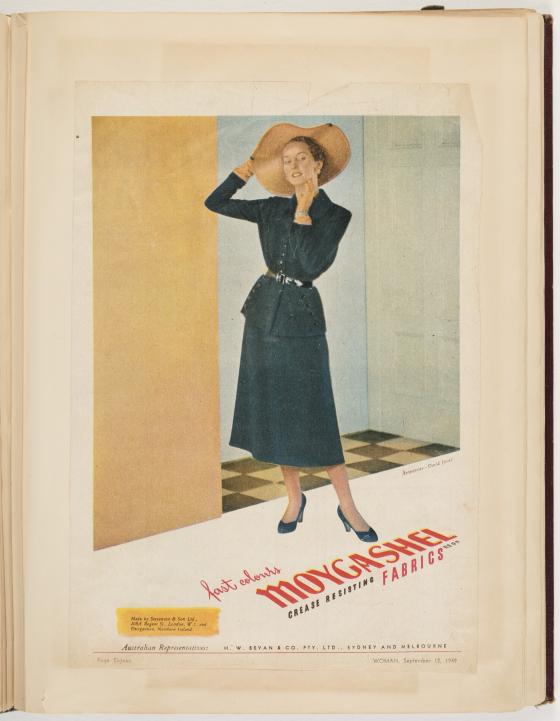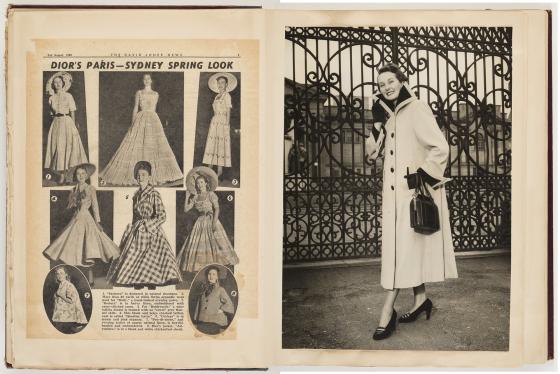The newspaper trail starts in 1947 and finishes in 1976. My grandmother’s pride in the scrapbooks is evident in every neat scissor cut, article crease and fold. Mum’s excitement is unmistakable in photographs of her joyful smiles. You can feel the thrill of their joint success through the pages. The fun of their adventure as they move into their new Sydney lives, perhaps a little wide-eyed but always determined.
In 2022 I donated June Dally-Watkins’s scrapbooks and journals to the State Library of NSW. They have many facets but they mostly chart the beginning of her modelling career, her triumphs in the United States, the growth of Australia’s fledgling fashion industry and the founding of the country’s first model agency. Miss Dally, as June Dally-Watkins would ultimately become known, was Australia’s first-ever supermodel, before the term had even been coined. She was also my mother.
Within the scrapbooks and journals now held by the Library are her descriptions of Hollywood and the famous people she met along the way. In the eyes of the Americans she worked with, this beautiful young Australian girl seemed to be a fresh and different creature, with a cute accent. My donation to the Library also includes the program of the first Christian Dior Fashion Parade in Australia which was, in fact, the fashion house’s first complete collection ever to be shown outside Paris. Mum was so proud of that original program, signed by every model. One wrote, ‘With love from me and my lipstick brush.’ There is humour and happiness in each inscription.
But the donation is also a poignant record of a mother and daughter relationship, between my mother and hers. I suspect it was only Nanna scouring the newspapers to fill those albums because Mum was so busy working. It was Nanna who stayed home to take Mum’s model bookings by phone, sewed her clothes and cooked their meals. Mum’s work supported them financially for a long time.
It’s an emotional thing knowing that Nanna’s love is glued all over these pages. So I guess it’s no wonder I got the last-minute wobbles about giving away such wonderful family memories. Initially, handing over Nanna and Mum’s scrapbooks to be archived felt wonderful, as though I was doing something of social value. I felt that bequeathing the albums would help Mum endure, that by making the albums public I might prompt a deeper understanding of the historical context for newspaper headings such as ‘Girls Lack Poise,’ or advertisements proclaiming ‘I’m lovelier since I changed to Innoxa’.
In our ‘politically correct’ lexicon, so much of what Mum stood and worked for is now challenged or even derided. In my daughter’s glossary, for example, expressions such as ‘Women don’t owe you pretty’ are common. Aspiring to being ‘poised’ or ‘lovely’ might now be seen as old-fashioned or weak. Definitions of femininity change, the notion of ‘ladylike behaviour’ is now seen as limiting or confining, though goodness knows what my mother would have made of the world of Instagram, and aspirations to be ‘hot’. Every generation of women has fought for change. In Mum’s day it was her battle to have children and to work after marriage that contributed to strides forward in the women's movement.
Like buyer’s remorse, does donor’s remorse exist? It did for me. The emotional confusion around giving up these documents gave me pause. Their contents are my family’s memories. Surely my children and nephews — and even their children — would appreciate the photos as they flicked through them? Maybe it was best for such personal records to be kept within the family? But, again, I thought it could all go towards fostering research and awareness of the limitations of the cultural world that my mother moved within and the achievements she made.
Indeed, the clippings are snapshots of life in the middle of the last century. Social pages, fashion shows, advertisements, fashion editorials, Australian Women’s Weekly fashion shoots, catalogues. Mum, like other remote country girls, grew up devouring these magazine stories, hanging onto every photo. But as time goes on, the scrapbooks take on a more serious tone. In 1952, for example, Mum helped form the Mannequins and Models Association of NSW to improve pay rates. ‘Photographers fees have gone up, but models are still receiving the same fees as fifteen years ago’, reads one article. The unionisation of the modelling industry had begun. The headline of another article blares ‘Models seek Actors’ Equity membership.’ Miss Dally was all for women’s rights, equal pay and equal opportunities. Not bad for an illegitimate girl born June Marie Skewes.
Nanna Kay, born Caroline Marie Skewes, must have been incredibly proud of her daughter who grew up in Watsons Creek (60 kilometres from Tamworth and with a population of 12), and climbed to the top of Australia’s business and fashion world. The closest town to my grandmother’s New England farm was Bendemeer, which apparently has the dubious distinction of being one of the first places Captain Thunderbolt robbed in 1864 when he held up the Northern Mail. Nanna was an unmarried mother. When Mum was born in 1927, not much was happening around Watsons Creek except for rabbit shooting and sheep shearing. The stigma of having a ‘bastard’ child in the bush was so disgraceful that, as Nanna and Mum told me years later, they were better off in the anonymous world of Sydney. When she was 14 years old, Mum was adopted by David Dally-Watkins, my grandmother’s first husband and the original owner of that elegant name.
My uncertainty about letting the public into our family life was no small thing, but those doubts did turn to conviction. Headings such as ‘T.A.A. Flies Fashion Around Australia to Test How Australian Designed Travel Clothes Stand Up to the Job’ are so wonderful I thought they should be shared. There are charming photos of Mum pretending to be asleep on that particular assignment that are captioned: ‘Our candid camera caught the mannequins asleep in their comfortable sleeperettes as they fly back from Adelaide to Perth.’ Headlines in another album are from Sun-Herald and Daily Mirror stories about my mother judging the Miss Sun Girl Quest, a beauty pageant that ran from Greenmount Beach on the South Coast along the beaches all the way north to Noosa. Beauty pageants may be controversial now but are clearly part of our heritage.
The scrapbooks under my care had languished in a cupboard since Mum died in 2020. We handled the albums with love and took pleasure in the memories, but it was perhaps a negligible love because really, we didn’t take any notice of them. No one ever ‘viewed’ the photos, read the articles, or stored them in a temperature-controlled environment to ensure their longevity. Perhaps children don’t give the legacy of their parents the respect it deserves. Inherited documents are taken for granted or considered a nuisance. ‘What are we going to do with those files?’, is an often-repeated phrase. Our heritage has always been there, we are born into our parent’s stories, we’ve never been in a world without them. We either take their historical value for granted, or want to change it.
So, I decided to give them away. Public access to records of the formative days of Australian fashion and modelling is important. Probably not many people under 30 have heard of June Dally-Watkins. Young people wouldn’t know who was at the helm of Australia’s first model-booking agency and perhaps, one day, some would like to find out. But a lot of people do remember June Dally-Watkins. So many, upon hearing her name, smile and say, ‘My sister did your mother’s course,’ or ‘My mother was a Dally’s girl,’ or even in one case, ‘My sister was chosen to dance with the Bluebells at the Lido on the Champs-Élysées cabaret show in Paris. But they wouldn’t take her unless she’d done the June Dally-Watkins course first.’
Once I’d made the decision to donate Mum’s files, I needed to better grasp how the Library would make the albums available. To be honest, I hadn’t reckoned on how much care would be taken. I booked some quiet time in the imposing Mitchell Reading Room to experience what it might be like for another researcher. I was given a stand-up Perspex sign saying I had permission to take photos. As a donor I have photographic rights, which made me smile. The catalogue box was then weighed before being passed over to me. The box’s weight helps archivists and librarians know if documents have been knowingly or unknowingly slipped into bags. Mum and Nanna weighed in at 3.611 kilograms. I pored over the photos and articles, probably for the last time, knowing they are in good hands. When cultural institutions acquire significant items, they are loved.
Now, I’ve absolutely made peace with the donation decision. The State Library of NSW is in my DNA now. Or is it the other way around? Mum and Nanna are in good company. Their neighbors in the five-level underground stacks vary from documents discussing the suitability of Princess Elizabeth’s wedding present, to the 1927-1931 Razor Gang Wars. Nanna would have loved all of that.
The word patrimony means property inherited from one’s father or male ancestor. Inheritance through the female line is termed ‘matrilinear’. But that word doesn’t do justice to how I feel about my donation. So, I’ll make up a word: Mumony. My mother would have adored that.
Lisa June Clifford is a writer and journalist, and June Dally-Watkins’ youngest daughter. Born in Sydney, she moved to Italy at 16 but returned for an Australian Film, Television and Radio School scholarship. After a career in radio and television journalism, Lisa resettled in Italy. She is the author of Walking Sydney, The Promise — An Italian Romance, Death in the Mountains and Naples: A Way of Love. She now lives between Florence and Sydney.
This story appears in Openbook spring 2023.







